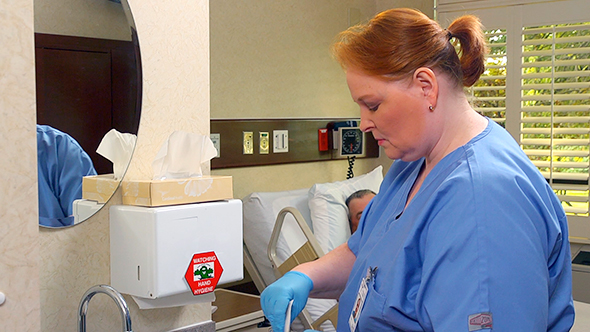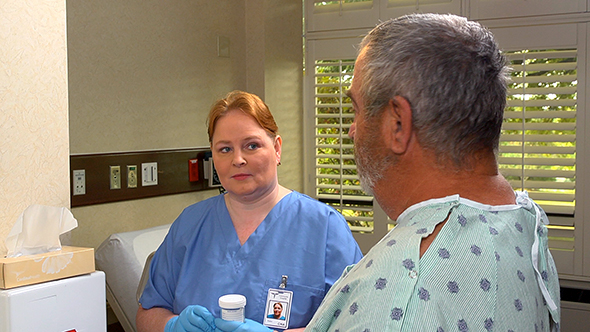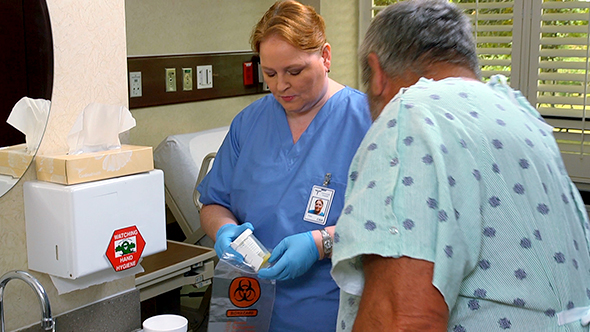Specimen Collection and Surgical Care
Select a Skill:
- » Collecting a Midstream Specimen
- » Collecting a 24-Hour Urine Specimen
- » Collecting and Testing a Stool Specimen
- » Collecting a Sputum Specimen
- » Measuring Blood Glucose
- » The Surgical Skin Prep—Shaving the Skin
- » Assisting with Deep Breathing and Coughing Exercises
Take the Review Test:

Purpose

- Respiratory disorders cause the lungs, bronchi, and trachea to secrete mucus. Mucus from the respiratory system is called sputum when expectorated (expelled) through the mouth.
- Sputum specimens are studied for blood, microbes, and abnormal cells. The person coughs up sputum from the bronchi and trachea. This is often painful and hard to do. It is easier to collect a specimen in the morning. Secretions collect in the trachea and bronchi during sleep. They are coughed up on awakening.
- To collect a specimen, have the person rinse the mouth with water. Rinsing decreases saliva and removes food particles. Mouthwash is not used. It destroys some microbes in the mouth. Also follow these rules for collecting specimens:
- Follow the rules of medical asepsis.
- Use a clean container for each specimen. Use the correct container.
- Do not touch the inside of the container or lid.
- Label the container in the person’s presence. Provide clear, accurate information.
- Collect the specimen at the correct time.
- Place the specimen container in a labeled biohazard plastic bag. Do not let the container touch the outside of the bag. Seal the bag.
- Take the specimen and requisition slip to the laboratory or storage area.
Equipment
Roll cursor over items to see labels. For the purposes of clearly depicting the equipment, a barrier is not shown in this photo. When providing care, a barrier should always be placed on the surface before placing the equipment.

Tissues
Specimen bag
Sputum specimen container and lid
Specimen label
Laboratory requisition slip
Gloves
Delegation
- Follow delegation guidelines. Before collecting a sputum specimen, obtain this information from the nurse and care plan:
- When to collect the specimen
- How much sputum is needed—usually 1 to 2 teaspoons
- If the person uses the bathroom
- If the person can hold the sputum container
- What observations to report and record
- When to report observations
- What patient or resident concerns to report at once
Preparation

- Observe quality-of-life measures.
- Review the information under Delegation and Safety and Comfort.
- Practice hand hygiene.
- Before going to the person’s room, collect the items on the equipment list, from the laboratory requisition slip through the biohazard label.
- Arrange collected items in the person’s bathroom.
- Practice hand hygiene.
- Identify the person. Check the ID bracelet against the requisition slip. Compare all information. Also call the person by name.
- Label the specimen container in the person’s presence.
- Collect gloves and tissues.
- Provide for privacy. If able, the person uses the bathroom for the procedure.
Safety

- Follow Standard Precautions and the Bloodborne Pathogen Standard to prevent contact with mucus. It may contain blood or microbes.
- The doctor may order isolation precautions if the person has or may have tuberculosis (TB). Protect yourself by wearing a TB respirator.
Comfort
- The procedure can embarrass the person. Coughing and expectorating sounds can disturb others. Also, sputum is not pleasant to look at. For these reasons, privacy is important. Cover the specimen container and place it in a bag. Some sputum specimen containers are cloudy in color to hide the contents.
Procedure Video
Audio Description: OFFFollow-up Care

- Provide for comfort.
- Place the call light within reach.
- Raise or lower the bed rails. Follow the care plan.
- Unscreen the person.
- Complete a safety check of the room.
- Practice hand hygiene.
- Deliver the specimen and requisition slip to the laboratory or storage area. Follow agency policy. Wear gloves.
- Remove and discard the gloves. Practice hand hygiene.
Reporting/Recording
- Report and record your observations, including:
- The time the specimen was collected
- The amount of sputum collected
- How easily the person raised the sputum
- Sputum color—clear, white, yellow, green, brown, or red
- Sputum odor—none or foul odor
- Sputum consistency—thick, watery, or frothy (with bubbles or foam)
- Hemoptysis (bloody sputum)
- If the person was not able to produce sputum
- Any other observations
Review Questions
Select the best answer.
1. What is the purpose of performing tests on a sputum specimen?
 To look for occult blood in the person’s saliva
To look for occult blood in the person’s saliva To identify blood, microbes, and abnormal cells
To identify blood, microbes, and abnormal cells To determine the amount of oxygen in the person’s lungs
To determine the amount of oxygen in the person’s lungs To evaluate the effectiveness of deep-breathing exercises
To evaluate the effectiveness of deep-breathing exercises
Select the best answer.
2. What is the best time of day to obtain a sputum specimen?
Select the best answer.
3. How much sputum should you expect to collect for a specimen?
Select the best answer.
4. When obtaining a sputum specimen, which action is appropriate?
 Assist the person into the supine position.
Assist the person into the supine position. Stand in front of the person to assist with collecting the specimen.
Stand in front of the person to assist with collecting the specimen. Instruct the person not to touch the inside of the specimen container.
Instruct the person not to touch the inside of the specimen container. Attach the completed identification label to the lid of the specimen container.
Attach the completed identification label to the lid of the specimen container.
Select the best answer.
5. After collecting a sputum specimen, you observe hemoptysis. What does this mean?
 The sputum is frothy.
The sputum is frothy. The sputum is bloody.
The sputum is bloody. The person is wheezing.
The person is wheezing. The person has difficulty breathing.
The person has difficulty breathing.
You have completed the Review Questions for this skill. To take the Review again select the Start Over button. To proceed to another skill select from the dropdown menu. Select the Home or Back button to proceed to the next section.

